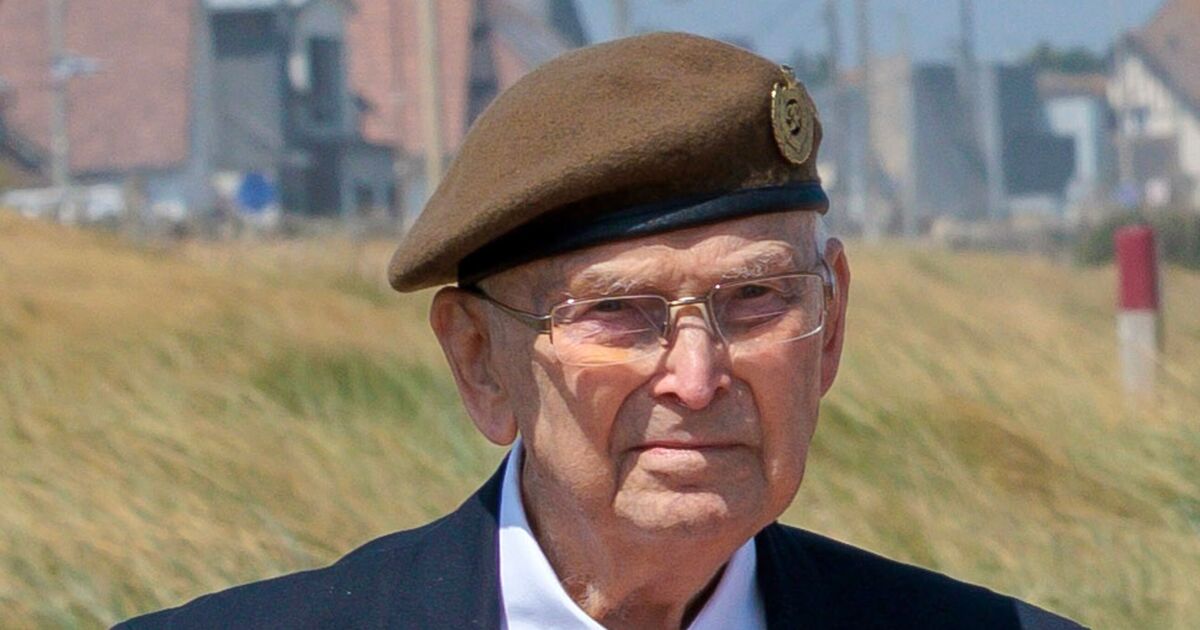Tributes have been paid to D-Day hero Reginald Pye after his death at 101.
Reginald, from Burry Port in Carmarthenshire, was a Royal Engineer in 1944 and cleared mines during the landings.
While moving through Normandy 14 days after the invasion, he spotted a 14-year-old girl staring at him while he ate his evening meal – a slice of bread with jam and a tin of pilchards.
Reg, then just 21, gave his bread and jam to the girl who ran away to eat it.
The following morning he found she had half-filled his mess tin with milk and left a handwritten note on the back of a picture of herself, which Reg kept in his wallet ever since.
In 2023, on the 79th anniversary of the landings, Reg was one of a band of brothers who travelled back to the scene of their greatest hour with the Daily Express for an iconic picture on Sword Beach.
Standing shoulder-to-shoulder, the heroes were dubbed the Magnificent Seven.
They returned to the exact spot where tens of thousands of soldiers desperately scrambled ashore amid a ferocious hail of anti-tank, mortar, machine-gun and rifle fire.
Standing on the windswept beach it was impossible to comprehend the magnitude of what unfolded at day break on June 6, 1944, and the blind courage it took to jump from landing craft, wade through the surf and crawl onto the shore as all hell broke loose.
Although almost eight decades had passed, the indelible memories of what they witnessed were undimmed by time.
And in a poignant moment in time proud, stoic, dutiful and indomitable Reginald stood alongside Ken Hay, Jack Quinn, Henry Rice, Stan Ford, Alec Penstone and Richard Aldred, all recipients of France’s highest order of merit, The Legion of Honour, to link arms once more.
If one day can be said to have determined the fate of generations to come across the world it was D-Day.
As the hardy veterans looked out on to the choppy English Channel they fought back tears remembering the uncertainty. As the sun rose and they waded ashore, not one of them knew if they would be alive when it set. Theirs was a lucky roll of the dice.
The Allied invasion of Normandy was the largest in history. More than 156,000 men landed on D-Day – of which 83,000 were from Britain and the Commonwealth.
Underneath a statue of his grandfather in Colleville-Montgomery, the seaside village renamed in 1946 in his honour, Field Marshal Montgomery’s Grandson – the current Viscount Montgomery of Alamein – Henry, told Reginald and his hero chums at a dedication and wreath-laying service: “Your courage, spirit, willingness and, if necessary, sacrifice of life, meant we have enjoyed long lasting peace secured at such a cost. We will not forget. And grandfather would be proud of you all.”
Mark Waring, Vice Chairman of Spirit of Normandy Trust said: “The battle for the freedom of Europe was undertaken by young men and women, most of whom had never ventured from Britain. Theirs may have started off as a means to strike back against an evil and oppressive regime, but once on the battlefields would become a fight for their friends and, in so many cases, their own survival.
“The Spirit of Normandy Trust does not receive any government funding and puts in considerable effort to raise funds to enable us to fulfil our commitment to the veterans while they are still with us. We are absolutely committed to ensuring that, as long as there are veterans who wish to return to Normandy and are fit enough to do so, we will take them there for their annual pilgrimage, without any cost to them. They have paid the price, it is our turn to repay them.”

